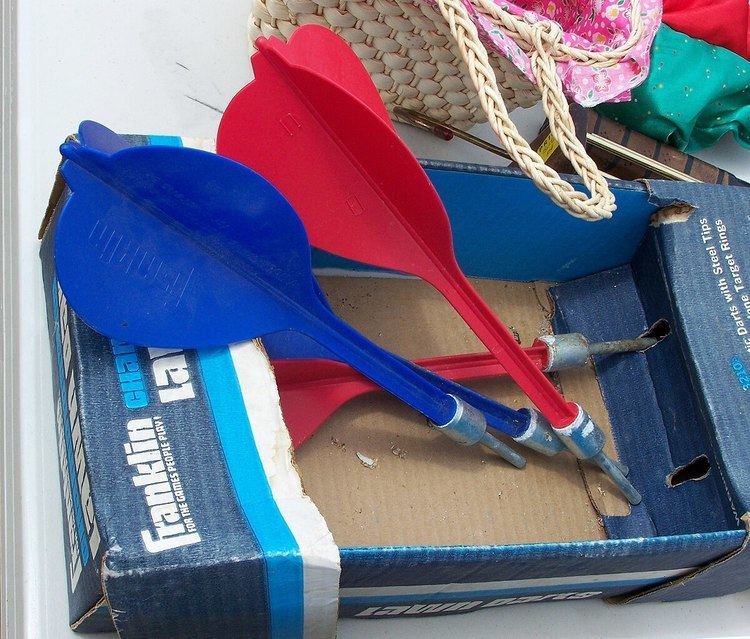 | ||
Lawn darts (also known as Javelin darts, jarts or yard darts) is a lawn game for two players or teams. A lawn dart set usually includes four large darts and two targets. The game play and objective are similar to both horseshoes and darts. The darts are similar to the ancient Roman plumbata. They are typically 12 inches (30 cm) long with a weighted metal or plastic tip on one end and three plastic fins on a rod at the other end. The darts are intended to be tossed underhand toward a horizontal ground target, where the weighted end hits first and sticks into the ground. The target is typically a plastic ring, and landing anywhere within the ring scores a point.
Contents
Rules
There are a number of variations of lawn darts, including Traditional and Handly Cup Style. Either variation can be played one-on-one or in teams of two. In the team version the players stand with one member from each team at each end (when throwing, they should be sure to stand well back when the other side is throwing) and toss the darts to a target about 35 feet (11 m) away (with variation based on the players' skill and the venue in which the game is being played).
In Traditional Lawn Darts, points are scored when a dart lands in the target area. Usually if a player from each team lands a dart in the target, the scores cancel each other (so if Team A got 2 darts into the target, and Team B got 1 in, Team A would get 1 point and Team B would get 0). Also, some versions of Lawn darts include a smaller "bulls-eye" ring for additional points.
In Handly Cup Style Lawn Darts, scores are based on darts in the ring plus darts closer to the ring than any of the opposing team's darts. Darts landing inside the ring, or "ringers", are worth 3 points each, and can be cancelled by an opponent also throwing a dart into the ring. Additionally, any dart that is closer to the ring (but outside) than any other dart by the opposing team is worth one point. This means that if neither team managed to place a dart into the ring, but Team A had two darts closer than any of Team B's darts, Team A would score 2 points. If Team A had one dart in the ring, and one dart closer than any of Team B's darts, they would score 4 points. If both teams have darts in the ring it is impossible for a dart outside the ring to score any points (as it is farther from the ring than the opposing team's dart that is inside). If Team A and Team B each had a dart inside the ring, and Team A also had a dart outside the ring but closer to the ring than Team B's other dart, neither team would score any points for that round. Handly Cup Style matches typically are played in teams of two, with the pairs alternating, until one team's total score is 21 or more. In addition, for a point to count the dart must stick into the ground.
Safety and bans
Lawn darts had been banned from being sold in the United States for many years. The ban was challenged in court in the late 1970s, prompting the Consumer Product Safety Commission to make a compromise ruling allowing their sale provided they were not marketed as toys. However, in April 1987, seven-year-old Michelle Snow was killed by a lawn dart thrown by one of her brothers' playmates in the backyard of their home in Riverside, California, United States. The darts had been purchased, unintentionally, as part of a set of several different lawn games and were stored in the garage, never before having been played. Michelle's father, David, began a crusade to get lawn darts banned, claiming that there was no way to keep children from getting their hands on lawn darts short of a full ban.
Due in part to Snow's lobbying, on December 19, 1988, the CPSC reinstated the outright ban on lawn darts in the USA. In the previous eight years, 6,100 people had been sent to the emergency room due to lawn darts in the USA. Out of that total, 81% were 15 or younger, and half of them were 10 or younger. On the week the commission voted to ban the product, an 11-year-old girl in Tennessee was hit by a lawn dart and sent into a coma.
Shortly after, in 1989, they were also banned in Canada. Since then, alternatives have surfaced that are available for sale in Canada and are made of plastic.
It is possible to import parts of a lawn dart – plastic flights, metal bodies, and steel spigots – as well as a complete set of replacement parts to repair damaged lawn darts, into the US and Canada. However, fully assembled individual darts, sets, and kits are banned from entry by American and Canadian customs authorities.
